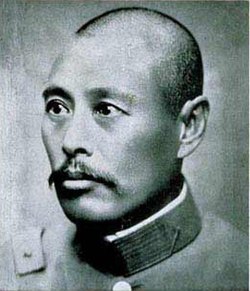Ren Xilian
Rèn Xīlián | |
|---|---|
| 任希濂 | |
 Ren Xilian in 1924 | |
| Minister of the Army | |
| In office 5th August 1920 – 14th April 1933 | |
| Monarch | Shanrong |
| Preceded by | Chang Yuanjun |
| Succeeded by | Qin Chuanli |
| Chief of staff of the commander-in-chief | |
| In office 26th July 1923 – 14th April 1933 | |
| Monarch | Shanrong |
| Preceded by | Zhao Hongjun |
| Succeeded by | Qin Xinyi |
| Personal details | |
| Born | April 5, 1883 |
| Died | April 22, 1937 (aged 54) |
| Political party | Nanqing Clique |
| Military service | |
| Allegiance | |
| Branch/service | |
| Rank | Grand Marshal |
| Battles/wars | Great War |
- This is a Shangean name; the family name is Ren (任).
Rèn Xīlián (任希濂; 任希濂) also known as Jen Hi Lien) was a Shangean military leader, politician and génocidaire who served as the de facto leader of the Heavenly Shangean Empire from 1923 to 1933 leading Shangea for the majority of the Great War. A member of the Church of Emperor Worship Ren was the leader of the Nanqing Clique and played a large role in the formation of the Emperor Worship regime in Shangea, the Gallo-Shangean Alliance, the decision to invade Senria and the Senrian Genocide.
Long in involved in radical activity in the Heavenly Shangean Army, Ren became a protégé of Qiu Hanjie, a fellow Emperor Worshipper, who after a series of crises within Shangea conspired to overthrow the existing imperial order. In 1920 the group alongside conventional militarists led by Zhao Hongjun overthrew the government in a coup d'état known as the Jiayin uprising. Ren, a junior member of the radical Nanqing clique, became Minister of the Army. As Army Minister Ren instilled ideological education promoting fellow Emperor Worshippers and purging members of the Zhao clique. The death of the Qingzhuo Emperor led to the new emperor, Shanrong, to side with the radicals In 1923 Zhao was removed as premier and Ren became chief-of-staff to the emperor, effectively becoming commander-in-chief of the Shangean Emperie.
Although a Ren ally Cao Guozhang became head of the civilian government Ren was real power forming a de facto dictatorship. An admirer of functionalist Gaullica Ren soon formed a regime based on a mixture of the Emperor Worship Church, Euclean-style National Functionalism and traditional Zohism. Ultimately the regime promoted Shangean ultranationalism which called for "crusade" against the Euclean powers and Senria. The regimes economic incompetence and ethnic cleansing campaigns led to unrest prior to the war whilst Ren built himself a large cult of personality.
Ren was the main advocate for the declaration of war against Senria in 1927 starting the Great war. A supreme commander of all Shangean armies Ren delegated authority for the Senrian front to his mentor Qiu but personally oversaw operations in Kuthina and Weranian-Southeast Coius. Under his direction the Senrian Genocide occurred which led to the death of over 9 million people.
In the face of military defeats Ren was stripped of all military and political positions in 1933. Retiring to his ancestral home in Nanqing Ren was captured by Senrian forces in December 1933 and sent to Rokkaku Prison in Keisi. Ren would be tried by the Inter-Allied Military Tribunal in Coius were he was convicted of crimes against peace, war crimes, and crimes against humanity. He was sentenced to death and executed in 1937, being one of two Entente heads of government (alongside Rafael Duclerque) to be executed for their role in the war.